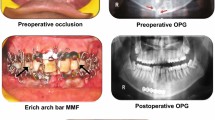Abstract
Purpose
Intermaxillary fixation (IMF) is a fundamental principle in the management of mandibular fractures but with recent advent of open reduction and internal fixation (ORIF), use of IMF is almost limited intraoperatively. Therefore, we compared the efficacy of Erich arch bar versus embrasure wires for intraoperative IMF in mandibular fractures.
Method
This prospective study was comprised of 50 patients with mandibular fractures who required ORIF with intraoperative IMF. Patients were categorized into two groups of 25 patients each: Erich arch bar technique was used for group A and embrasure wire technique for group B. Parameters were time taken for IMF, needle stick injury, occlusal stability, iatrogenic complications, and periodontal status of patients.
Statistical analysis
Chi-squared test and unpaired t test analyses was run on IBM SPSS 21.0 version (2015) software.
Result
Mean time for placing embrasure wire (3.48 min) was significantly less than that for Erich arch bar (48.08 min). Needle stick injury rates to the operator as well as the assistants were significantly less when using the embrasure wire than the Erich arch bar. The Erich arch bar had significantly superior postoperative occlusion stability. Iatrogenic injury was more common when placing the Erich arch bar than the embrasure wire. Postoperative oral hygiene status was good in patients that received the embrasure wire.
Conclusion
Embrasure wire technique is a quick, easy, and reliable technique for minimally or moderately displaced fractured mandible and had better clinical outcomes than did patients that underwent the Erich arch bar technique.




















Similar content being viewed by others
References
Motamedi MH, Dadgar E, Ebrahimi A, Shirani G, Haghighat A, Jamalpour MR (2014) Pattern of maxillofacial fractures: a 5-year analysis of 8,818 patients. J Trauma Acute Care Surg 77(4):630–634
Baurmash H, Farr D, Baurmash M (1988) Direct bonding of arch bars in the management of maxillomandibular injuries. J Oral Maxillofac Surg 46(9):813–815
Hollows P, Brennan J (2008) Temporary maxillomandibular fixation: a quick reliable method. Br J Oral Maxillofac Surg 37(5):422–423
Coletti DP, Salama A, Caccamese JF (2007) Application of intermaxillary fixation screws in maxillofacial trauma. J Oral Maxillofac Surg 65(9):1746–1750
Hashemi HM, Parhiz A (2011) Complications using Intermaxillary fixation screws. J Oral Maxillofac Surg 69(5):1411–1414
Engelstad ME, Kelly P (2011) Embrasure wires for intraoperative maxillomandibular fixation are rapid and effective. J Oral Maxillofac Surg 69(1):120–124
Chhabra N, Chhabra S, Thapar D (2015) Evaluation of two different methods of arch bar application: a comparative prospective study. J Maxillofac Oral Surg 14(2):432 40
US Public Health Service (2001) Updated US Public Health Service Guidelines for the management of occupational exposures to HBV, HCV, and HIV and recommendations for postexposure prophylaxis. MMWR Recomm Rep 50(11):1–52
Avery CME, Hjort A, Walsh S, Johnson PA (1998) Glove perforation during surgical extraction of wisdom teeth. Oral Surg Oral Med Oral Pathol Oral Radiol Endod 86(1):23–25
Tracy K, Gutta R (2015) Are embrasure wires better than arch bars for intermaxillary fixation? J Oral Maxillofac Surg 73(1):117–122
Baurmash H (1993) Bonded arch bars in oral and maxillofacial surgery: an update. Oral Surg Oral Med Oral Pathol 76(5):553–556
Author information
Authors and Affiliations
Corresponding author
Ethics declarations
Conflict of interest
The authors declare that they have no conflict of interest.
Informed consent
Informed consent was obtained from all patients.
Ethical approval
Institutional Ethical Committee approval was obtained before commencement of this study.
Rights and permissions
About this article
Cite this article
Satpute, A.S., Mohiuddin, S.A., Doiphode, A.M. et al. Comparison of Erich arch bar versus embrasure wires for intraoperative intermaxillary fixation in mandibular fractures. Oral Maxillofac Surg 22, 419–428 (2018). https://doi.org/10.1007/s10006-018-0723-9
Received:
Accepted:
Published:
Issue Date:
DOI: https://doi.org/10.1007/s10006-018-0723-9




